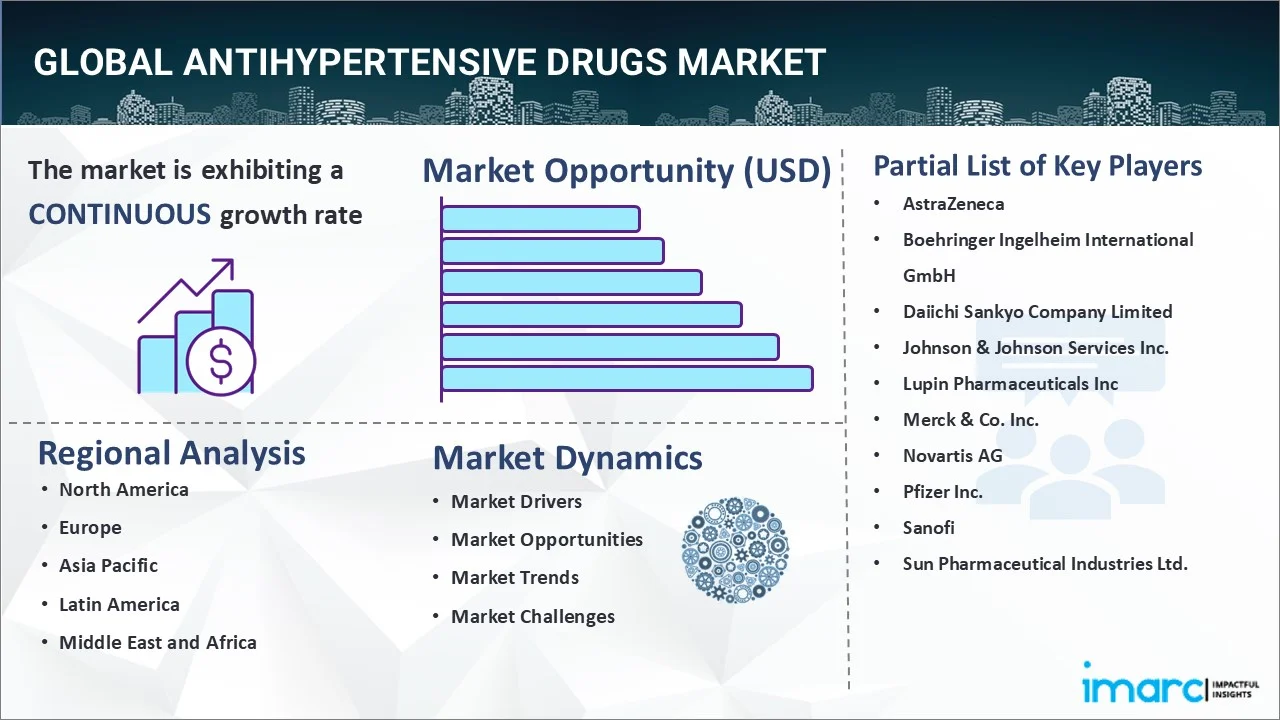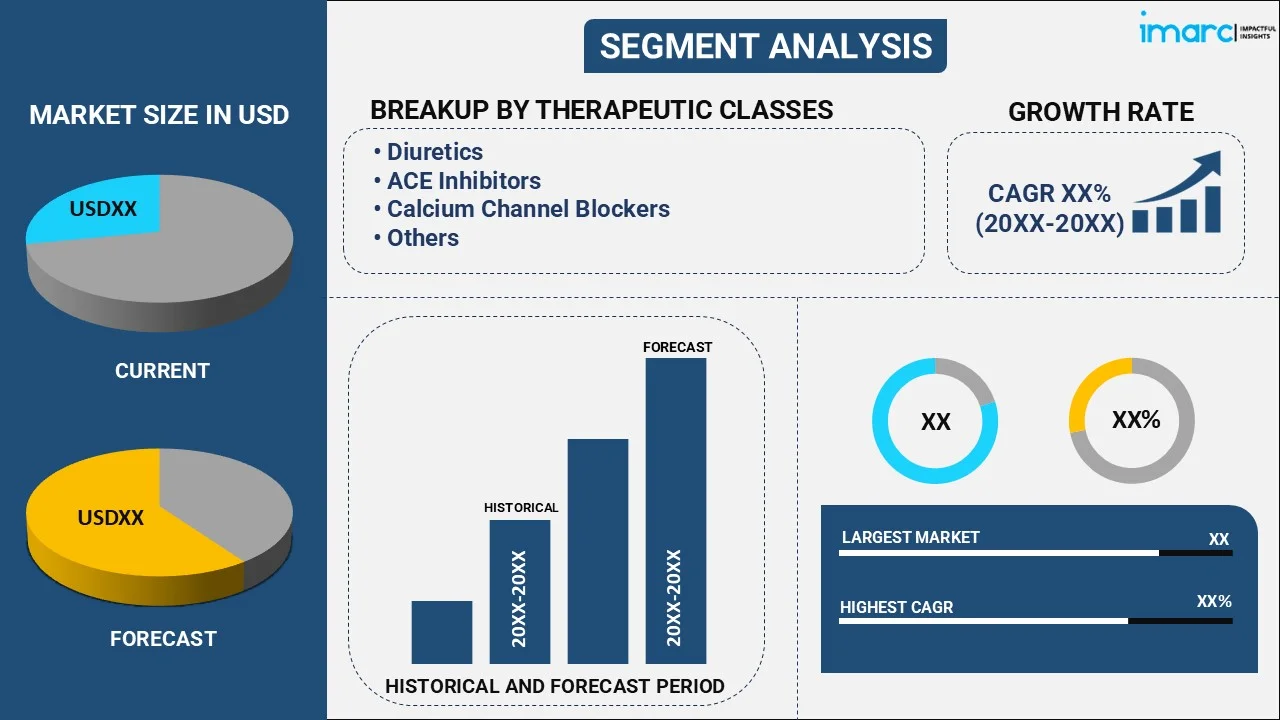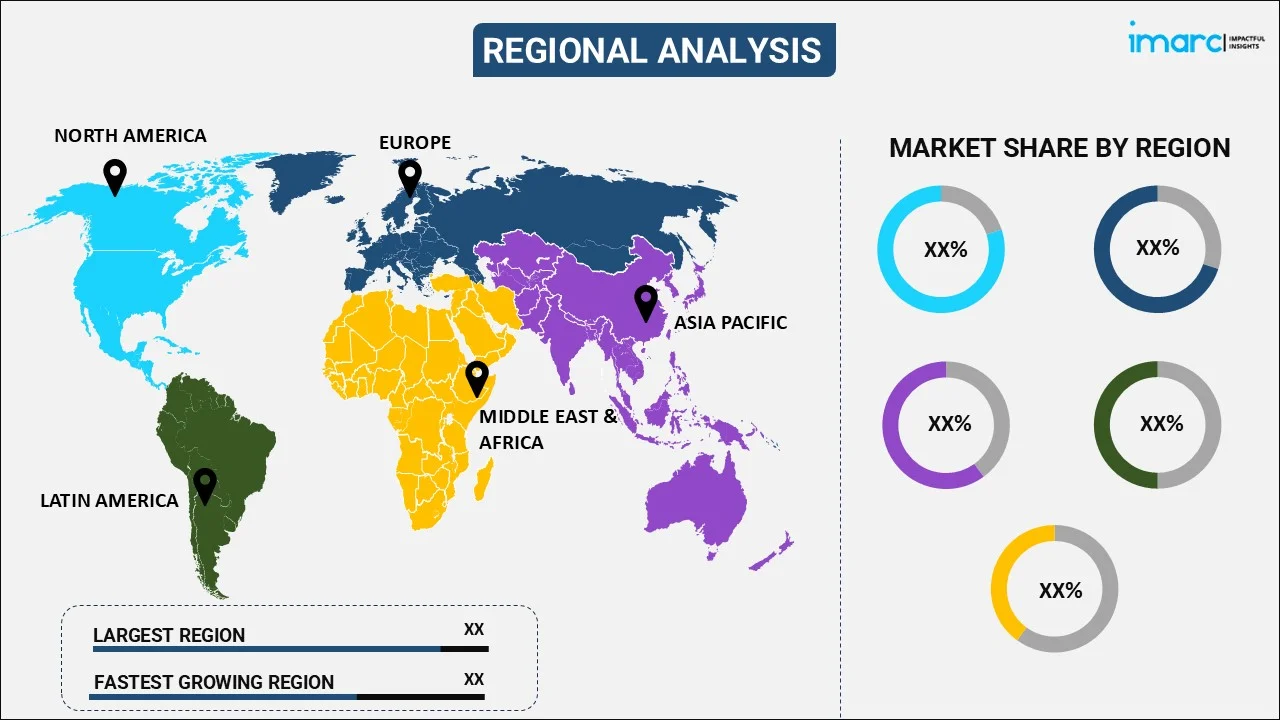
Antihypertensive Drugs Market Report by Therapeutic Class (Diuretics, ACE Inhibitors, Calcium Channel Blockers, Beta-adrenergic Blockers, Vasodilators, and Others), Type (Primary Hypertension, Secondary Hypertension), Distribution Channel (Retail Pharmacy, Hospital Pharmacy, E-Commerce), and Region 2025-2033
Antihypertensive Drugs Market Overview:
The global antihypertensive drugs market size reached USD 30.5 Billion in 2024. Looking forward, IMARC Group expects the market to reach USD 38.4 Billion by 2033, exhibiting a growth rate (CAGR) of 2.6% during 2025-2033. The market is driven by the growing number of people suffering from hypertension, rising geriatric population, as they are highly susceptible to hypertension, and increasing preferences for generic drugs due to the encouragement of many health insurance companies.
|
Report Attribute
|
Key Statistics
|
|---|---|
|
Base Year
|
2024
|
|
Forecast Years
|
2025-2033
|
|
Historical Years
|
2019-2024
|
|
Market Size in 2024
|
USD 30.5 Billion |
|
Market Forecast in 2033
|
USD 38.4 Billion |
| Market Growth Rate 2025-2033 | 2.6% |
Antihypertensive Drugs Market Analysis:
- Major Market Drivers: The rising incidences of hypertension worldwide is supporting the market growth.
- Key Market Trends: The growing demand for generic drugs, as they are less expensive, is positively influencing the market.
- Geographical Trends: North America enjoys the leading position in the market driven by the widespread access to healthcare services and regular screening programs.
- Competitive Landscape: Some of the major market players in the industry include AstraZeneca, Boehringer Ingelheim International GmbH, Daiichi Sankyo Company Limited, Johnson & Johnson Services Inc., Lupin Pharmaceuticals Inc, Merck & Co. Inc., Novartis AG, Pfizer Inc., Sanofi, Sun Pharmaceutical Industries Ltd., among many others.
- Challenges and Opportunities: Challenges in the market include drug side effects, patient non-adherence, and generic competition, while opportunities lie in the development of novel drug formulations and combination therapies.

Antihypertensive Drugs Market Trends:
Increasing prevalence of hypertension
The data published on the website of the World Health Organization (WHO) in 2023 shows that around 1.28 billion adults aged 30–79 years have hypertension around the world. As more people are diagnosed with hypertension, the total number of patients who need therapy is increasing. The expanding patient population is catalyzing the demand for antihypertensive drugs. More people are undergoing routine blood pressure checks as they are becoming more aware about the consequences of hypertension. Early detection enables timely intervention, resulting in a greater market for antihypertensive medications. Hypertension is frequently a chronic illness requiring long-term treatment. This produces a continual demand for antihypertensive drugs since patients require continuing treatment to control their blood pressure.
Growing geriatric population
The increasing elderly population is driving the demand for these drugs, as they are highly susceptible to hypertension.SS As the population is aging, the number of people who need antihypertensive drugs is rising. Older persons frequently have many chronic disorders, such as hypertension, diabetes, and cardiovascular disease. This needs thorough management, thereby catalyzing the antihypertensive drugs demand as part of their treatment plan. Increased life expectancy indicates that more people are living into old age, which increases the risk of acquiring hypertension. This demographic shift leads to a greater patient population needing hypertension treatment. Many healthcare systems prioritize chronic illnesses in the elderly, which leads to regular hypertension tests. Prescriptions for antihypertensive medicines are increasing as healthcare access improves and specific measures to regulate blood pressure in older individuals become more prevalent. Older folks are becoming more aware about the risks associated with untreated hypertension. Educational initiatives and health campaigns encourage seniors to regularly check their blood pressure, which leads to more diagnosis and subsequent prescription use. As per the data published on the website of the World Health Organization (WHO) in 2024, the world’s population of people aged 60 years and older is anticipated to reach 2.1 billion by 2050.
Rising demand for generic drugs
The IMARC Group’s report shows that the global generic drugs market size reached USD 367.1 Billion in 2023. Generic antihypertensive medications are often less expensive than their branded counterparts. As healthcare costs are rising, patients and providers are increasingly turning to generics to cut costs, which is propelling the antihypertensive drugs market growth. Generic drugs improve access to therapy for a larger population. Many health insurance companies encourage the use of generic pharmaceuticals by offering lower copays than branded medications. This insurance incentive is driving the demand for generic antihypertensive medications. As the patents for branded antihypertensive medications expire, more generic manufacturers enter the market, which is increasing the competition. This competition not only cuts prices, but also increases the diversity of accessible treatments.
Antihypertensive Drugs Market Segmentation:
IMARC Group provides an analysis of the key trends in each segment of the market, along with forecasts at the global, regional, and country levels for 2025-2033. Our report has categorized the market based on therapeutic class, type, and distribution channel.
Breakup by Therapeutic Class:

- Diuretics
- ACE Inhibitors
- Calcium Channel Blockers
- Beta-adrenergic Blockers
- Vasodilators
- Others
Calcium channel blockers account for the majority of the market share
The report has provided a detailed breakup and analysis of the market based on the therapeutic class. This includes diuretics, ACE inhibitors, calcium channel blockers, beta-adrenergic blockers, vasodilators, and others. According to the report, calcium channel blockers represent the largest segment.
Calcium channel blockers (CCBs) are extremely effective at lowering blood pressure by blocking calcium entrance into vascular smooth muscle and cardiac cells. This causes vasodilation, which reduces systemic vascular resistance and improves hypertension management. They are appropriate for a wide spectrum of patients, including those with isolated systolic hypertension, which is common among older persons. Their ability to target diverse populations helps to their market dominance. They are frequently used in conjunction with other antihypertensive drugs, such as ACE inhibitors and diuretics. This adaptability in treatment regimens increases their use and appeal in hypertension therapy, hence expanding their market position. CCBs have a better safety profile, with fewer adverse effects than some other antihypertensive groups.
Breakup by Type:
- Primary Hypertension
- Secondary Hypertension
Primary hypertension holds the largest share of the industry
A detailed breakup and analysis of the market based on the type have also been provided in the report. This includes primary hypertension and secondary hypertension. According to the report, primary hypertension accounts for the largest market share.
Primary hypertension accounts for majority of all hypertension patients. Its great prevalence in the general population is catalyzing the demand for antihypertensive drugs, as a huge number of people require therapy. Primary hypertension is frequently a chronic illness that requires ongoing care. This leads in a constant need for antihypertensive medications, which contributes to long-term market growth because patients require ongoing treatment to maintain their blood pressure. The elderly population is especially vulnerable to primary hypertension. As people age, their chances of acquiring hypertension increase, resulting in a larger patient population in need of antihypertensive drugs. Obesity, sedentary activity, poor eating habits, and high stress levels are all contributing to the antihypertensive drugs market revenue.
Breakup by Distribution Channel:
- Retail Pharmacy
- Hospital Pharmacy
- E-Commerce
Hospital pharmacy represents the leading market segment
The report has provided a detailed breakup and analysis of the market based on the distribution channel. This includes retail pharmacy, hospital pharmacy, and e-commerce. According to the report, hospital pharmacy represents the largest segment.
Hospital pharmacies play an important role in the healthcare system by giving pharmaceuticals directly to patients who have been admitted for treatment. Many hypertensive patients are treated in hospitals for related issues, hence hospital pharmacies are the principal supplier of antihypertensive medications. Hospital physicians frequently prescribe antihypertensive drugs as part of complete treatment strategies for patients suffering from hypertension or other cardiovascular problems. This technique increases the amount of antihypertensive medication dispensed by hospital pharmacies. Hospital pharmacies also provide fast access to antihypertensive medications, which is critical for treating severe hypertension crises or consequences. This promptness ensures that patients receive timely care, reinforcing the hospital pharmacy's function as an important distribution route.
Breakup by Region:

- North America
- United States
- Canada
- Asia-Pacific
- China
- Japan
- India
- South Korea
- Australia
- Indonesia
- Others
- Europe
- Germany
- France
- United Kingdom
- Italy
- Spain
- Russia
- Others
- Latin America
- Brazil
- Mexico
- Others
- Middle East and Africa
North America leads the market, accounting for the largest antihypertensive drugs market share
The report has also provided a comprehensive analysis of all the major regional markets, which include North America (the United States and Canada); Asia Pacific (China, Japan, India, South Korea, Australia, Indonesia, and others); Europe (Germany, France, the United Kingdom, Italy, Spain, Russia, and others); Latin America (Brazil, Mexico, and others); and the Middle East and Africa. According to the report, North America represents the largest regional market for antihypertensive drugs.
North America has a high prevalence of hypertension, driven by lifestyle factors, such as poor diet, high levels of stress, obesity, and a sedentary lifestyle. The aging population further exacerbates the issue, as older adults are more prone to hypertension. This region also has advanced healthcare infrastructure, with widespread access to healthcare services and regular screening programs, which lead to early diagnosis and treatment of hypertension. Additionally, key players in the region are focusing on strong pharmaceutical research and development (R&D) activities, resulting in the availability of innovative and effective antihypertensive drugs. For instance, in 2023, Merck showed new analyses supporting the promising potential of sotatercept, its investigational medicine for adults with pulmonary arterial hypertension (PAH).
Competitive Landscape:
- The antihypertensive drugs market research report has also provided a comprehensive analysis of the competitive landscape in the market. Detailed profiles of all major companies have also been provided. Some of the major market players in the industry include AstraZeneca, Boehringer Ingelheim International GmbH, Daiichi Sankyo Company Limited, Johnson & Johnson Services Inc., Lupin Pharmaceuticals Inc, Merck & Co. Inc., Novartis AG, Pfizer Inc., Sanofi, and Sun Pharmaceutical Industries Ltd.
(Please note that this is only a partial list of the key players, and the complete list is provided in the report.)
- Key players in the market are actively focusing on various strategies to strengthen their market position and meet the growing demand for effective hypertension treatments. Many leading pharmaceutical companies are investing heavily in research and development (R&D) activities to introduce new and improved antihypertensive drugs with better efficacy and fewer side effects. They are also exploring combination therapies that can address multiple cardiovascular issues in a single treatment. Additionally, several antihypertensive drugs companies are expanding their product portfolios by launching generic versions of popular antihypertensive medications to cater to price-sensitive markets. Collaborations and partnerships with research institutions and healthcare providers are becoming more common, aimed at improving access to hypertension treatments globally. They are also focusing on mergers and acquisitions (M&A) to expand their customer base. For instance, in 2023, Novo Nordisk A/S and KBP Biosciences PTE., Ltd. announced that Novo Nordisk acquired ocedurenone to leverage its best-in-class potential in treating uncontrolled hypertension.
Antihypertensive Drugs Market News:
- September 2024: Keros Therapeutics, Inc. announced that it has closed screening for the TROPOS trial, a Phase 2 clinical trial of cibotercept (KER-012) in combination with background therapy in patients with pulmonary arterial hypertension (PAH). Cibotercept is being developed for the treatment of PAH among patients.
- April 2023: Mochida Pharmaceutical Co., Ltd. announced about the launch of Treprost® Inhalation Solution 1.74mg, a treatment for pulmonary arterial hypertension (PAH) in Japan.
Antihypertensive Drugs Market Report Scope:
| Report Features | Details |
|---|---|
| Base Year of the Analysis | 2024 |
| Historical Period | 2019-2024 |
| Forecast Period | 2025-2033 |
| Units | Billion USD |
| Scope of the Report | Exploration of Historical Trends and Antihypertensive Drugs Market Outlook, Industry Catalysts and Challenges, Segment-Wise Historical and Future Market Assessment:
|
| Therapeutic Classes Covered | Diuretics, ACE Inhibitors, Calcium Channel Blockers, Beta-Adrenergic Blockers, Vasodilators, Others |
| Types Covered | Primary Hypertension, Secondary Hypertension |
| Distribution Channels Covered | Retail Pharmacy, Hospital Pharmacy, E-Commerce |
| Regions Covered | Asia Pacific, Europe, North America, Latin America, Middle East and Africa |
| Countries Covered | United States, Canada, Germany, France, United Kingdom, Italy, Spain, Russia, China, Japan, India, South Korea, Australia, Indonesia, Brazil, Mexico |
| Companies Covered | AstraZeneca, Boehringer Ingelheim International GmbH, Daiichi Sankyo Company Limited, Johnson & Johnson Services Inc., Lupin Pharmaceuticals Inc, Merck & Co. Inc., Novartis AG, Pfizer Inc., Sanofi, Sun Pharmaceutical Industries Ltd., etc. |
| Customization Scope | 10% Free Customization |
| Post-Sale Analyst Support | 10-12 Weeks |
| Delivery Format | PDF and Excel through Email (We can also provide the editable version of the report in PPT/Word format on special request) |
Key Questions Answered in This Report:
- How has the global antihypertensive drugs market performed so far, and how will it perform in the coming years?
- What are the drivers, restraints, and opportunities in the global market?
- What is the impact of each driver, restraint, and opportunity on the global market?
- What are the key regional markets?
- Which countries represent the most attractive market?
- What is the breakup of the market based on the therapeutic class?
- Which is the most attractive therapeutic class in the market?
- What is the breakup of the market based on the type?
- Which is the most attractive type in the market?
- What is the breakup of the market based on the distribution channel?
- Which is the most attractive distribution channel in the market?
- What is the competitive structure of the market?
- Who are the key players/companies in the global antihypertensive drugs market?
Key Benefits for Stakeholders:
- IMARC’s industry report offers a comprehensive quantitative analysis of various market segments, historical and current market trends, antihypertensive drugs market forecasts, and dynamics of the market from 2019-2033.
- The research report provides the latest information on the market drivers, challenges, and opportunities in the global antihypertensive drugs market.
- The study maps the leading, as well as the fastest-growing, regional markets. It further enables stakeholders to identify the key country-level markets within each region.
- Porter's five forces analysis assists stakeholders in assessing the impact of new entrants, competitive rivalry, supplier power, buyer power, and the threat of substitution. It helps stakeholders to analyze the level of competition within the antihypertensive drugs industry and its attractiveness.
- The competitive landscape allows stakeholders to understand their competitive environment and provides insight into the current positions of key players in the market.
Need more help?
- Speak to our experienced analysts for insights on the current market scenarios.
- Include additional segments and countries to customize the report as per your requirement.
- Gain an unparalleled competitive advantage in your domain by understanding how to utilize the report and positively impacting your operations and revenue.
- For further assistance, please connect with our analysts.
 Inquire Before Buying
Inquire Before Buying
 Speak to an Analyst
Speak to an Analyst
 Request Brochure
Request Brochure
 Request Customization
Request Customization




.webp)




.webp)












